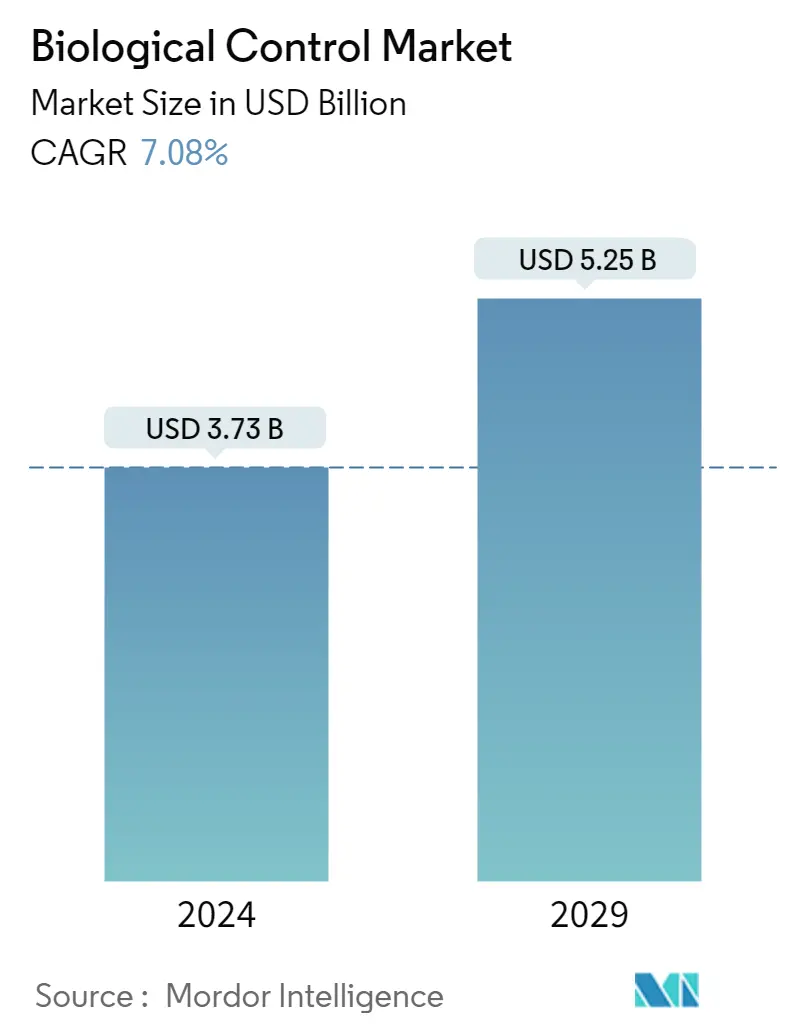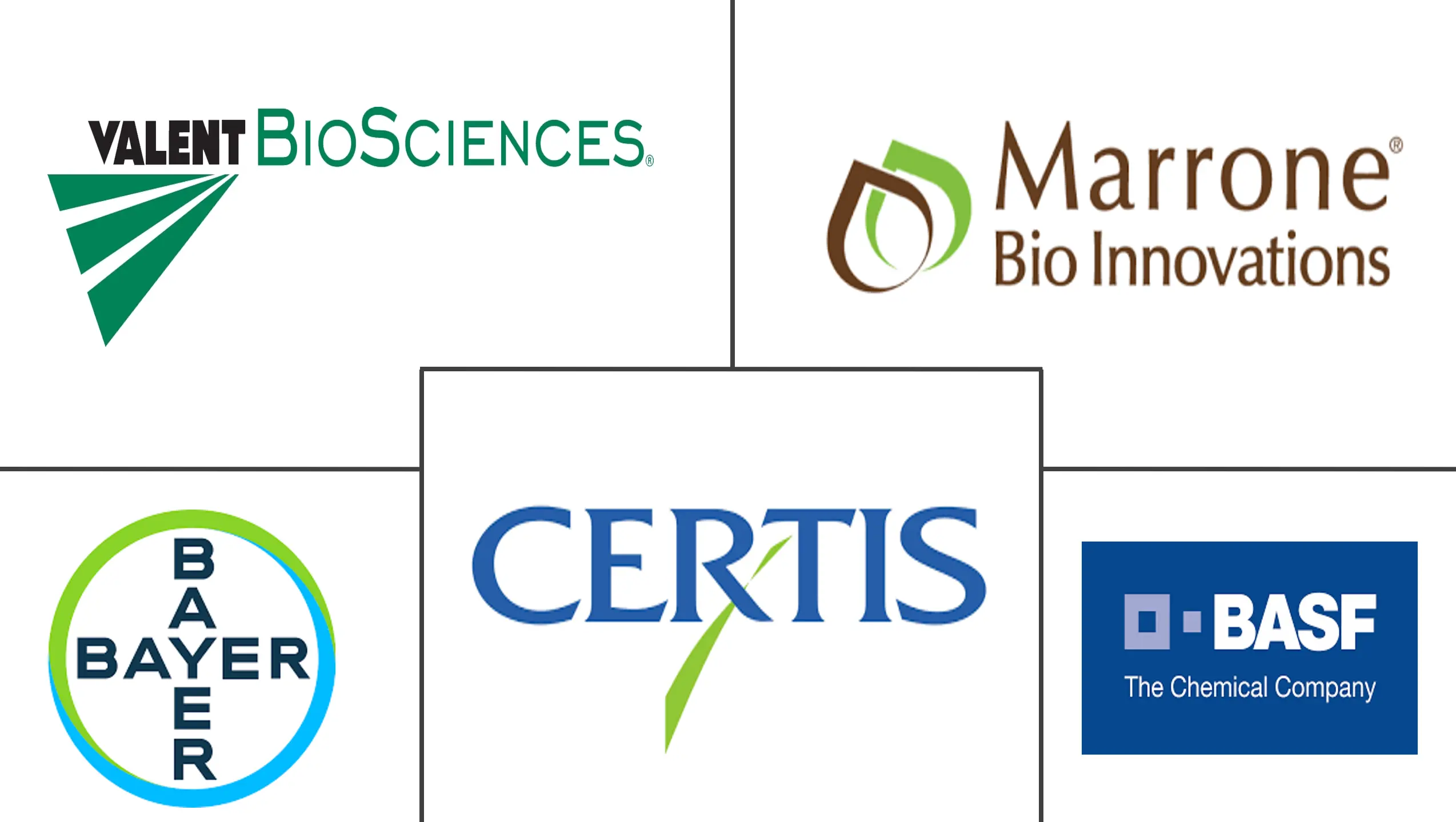Market Size of Biological Control Industry

| Study Period | 2017 - 2029 |
| Market Size (2024) | USD 3.73 Billion |
| Market Size (2029) | USD 5.25 Billion |
| CAGR (2024 - 2029) | 7.08 % |
| Fastest Growing Market | Asia Pacific |
| Largest Market | North America |
| Market Concentration | Low |
Major Players
*Disclaimer: Major Players sorted in no particular order |
Biological Control Market Analysis
The Biological Control Market size is estimated at USD 3.73 billion in 2024, and is expected to reach USD 5.25 billion by 2029, growing at a CAGR of 7.08% during the forecast period (2024-2029).
- Biological Control methods are environmentally friendly, have no harmful effects on humans compared to synthetic agrochemicals, and are effective throughout the season, therefore making them ideal for pest control. Rising public concern about synthetic pesticide hazards to the human body coupled with growing regulations on synthetic chemicals in farming and subsequent bans on such chemicals across the world drives the biological control market during the coming year.
- Due to their lower cost than pesticides, biological controls are becoming more popular, which is fostering the expansion of the market. The need for it is growing daily because it can replace chemical agents by reducing emissions into the environment, which in turn leads to less soil and water pollution. Further, the increasing area under organic cultivation, less stringent regulations, and increasing need for food security are the major market drivers that are boosting the sales of biologicals. However, the less self-life of the product and low awareness among the farmers are likely to restrain the market growth.
- The developed country like United States is adopting biological control, mainly in case of soil treatment, to strengthen the crop productivity and vigor at an early stage. The rising cost of pesticides, which has, in turn, led to high usage of biological control products.
- The market is still in its initial stages. Increased R&D collaborations, partnerships, and other activities are underway to develop and expand the biological control market, which is expected to grow as consumer preferences shift toward organic food products. For instance, in march 2021, Bayer AG introduced Vynyty citrus, a crop protection product based on biological and pheromones to control pests on citrus farms. The product is currently being used in Spain and is available to growers of citrus and other crops in other Mediterranean countries.
Biological Control Industry Segmentation
Biological control is a pest management strategy based on the reduction of pest populations by natural enemies or biological control agents. The Biological Control Market is segmented by Type (Microbials, Macrobials, and Entomopathogenic Nematodes), Target Pest (Arthropods, Weeds, and Microorganisms), Application (Seed Treatment, On-Field, and Post-Harvest), Crop Application (Grains and Cereals, Oilseeds and Pulses, Fruits and Vegetables, and Other Crop Applications), and Geography (North America, Europe, Asia-Pacific, South America, and Rest of the World). The report offers the market size and forecasts in terms of value in USD thousand for all the above segments.
| Type | |||||
| |||||
| |||||
| Entomopathogenic Nematodes |
| Target Pest | |
| Arthropods | |
| Weeds | |
| Microorganisms |
| Application | |
| Seed Treatment | |
| On-field | |
| Post Harvest |
| Crop Application | |
| Grains and Cereals | |
| Oilseeds and Pulses | |
| Fruits and Vegetables | |
| Other Crop Applications |
| Geography | |||||||||
| |||||||||
| |||||||||
| |||||||||
| |||||||||
|
Biological Control Market Size Summary
The biological control market is poised for significant growth, driven by increasing public concern over the hazards of synthetic pesticides and the rising demand for environmentally friendly pest control solutions. Biological control methods, which are less harmful to humans and effective throughout the growing season, are gaining traction as alternatives to synthetic agrochemicals. This shift is further supported by global regulations banning synthetic chemicals in agriculture and the growing area under organic cultivation. The market is also benefiting from the rising cost of traditional pesticides, which has led to increased adoption of biological control products. However, challenges such as the shorter shelf life of biological products and limited awareness among farmers may hinder market expansion.
North America, particularly the United States, leads the biological control market due to its advanced agricultural sector and abundant arable land. The region's market growth is fueled by concerns over the environmental impact of chemical inputs and the effectiveness of microbial pesticides. The market is characterized by a fragmented landscape with numerous small and regional players, alongside major companies like Certis, BASF SE, and Bayer CropScience AG, which are actively pursuing partnerships and mergers to strengthen their market position. Innovations in biological control products and increased consumer interest in organic products are expected to further drive market growth in the coming years.
Biological Control Market Size - Table of Contents
-
1. MARKET DYNAMICS
-
1.1 Market Overview
-
1.2 Market Drivers
-
1.3 Market Restraints
-
1.4 Porter's Five Forces Analysis
-
1.4.1 Threat of New Entrants
-
1.4.2 Bargaining Power of Buyers
-
1.4.3 Bargaining Power of Suppliers
-
1.4.4 Threat of Substitute Products
-
1.4.5 Intensity of Competitive Rivalry
-
-
-
2. MARKET SEGMENTATION
-
2.1 Type
-
2.1.1 Microbials
-
2.1.1.1 Bacteria
-
2.1.1.2 Viruses
-
2.1.1.3 Fungi
-
-
2.1.2 Macrobials
-
2.1.2.1 Parasitoids
-
2.1.2.2 Predators
-
-
2.1.3 Entomopathogenic Nematodes
-
-
2.2 Target Pest
-
2.2.1 Arthropods
-
2.2.2 Weeds
-
2.2.3 Microorganisms
-
-
2.3 Application
-
2.3.1 Seed Treatment
-
2.3.2 On-field
-
2.3.3 Post Harvest
-
-
2.4 Crop Application
-
2.4.1 Grains and Cereals
-
2.4.2 Oilseeds and Pulses
-
2.4.3 Fruits and Vegetables
-
2.4.4 Other Crop Applications
-
-
2.5 Geography
-
2.5.1 North America
-
2.5.1.1 United States
-
2.5.1.2 Canada
-
2.5.1.3 Mexico
-
2.5.1.4 Rest of North America
-
-
2.5.2 Europe
-
2.5.2.1 Germany
-
2.5.2.2 United Kingdom
-
2.5.2.3 France
-
2.5.2.4 Spain
-
2.5.2.5 Italy
-
2.5.2.6 Russia
-
2.5.2.7 Rest of Europe
-
-
2.5.3 Asia Pacific
-
2.5.3.1 China
-
2.5.3.2 Japan
-
2.5.3.3 India
-
2.5.3.4 Australia
-
2.5.3.5 Rest of Asia Pacific
-
-
2.5.4 South America
-
2.5.4.1 Brazil
-
2.5.4.2 Argentina
-
2.5.4.3 Rest of South America
-
-
2.5.5 Rest of the World
-
2.5.5.1 South Africa
-
2.5.5.2 Other Countries
-
-
-
Biological Control Market Size FAQs
How big is the Biocontrol Agents Market?
The Biocontrol Agents Market size is expected to reach USD 3.73 billion in 2024 and grow at a CAGR of 7.08% to reach USD 5.25 billion by 2029.
What is the current Biocontrol Agents Market size?
In 2024, the Biocontrol Agents Market size is expected to reach USD 3.73 billion.

